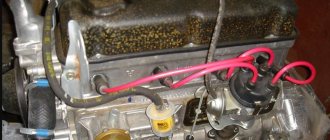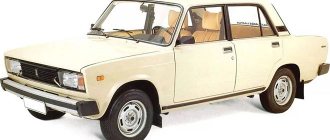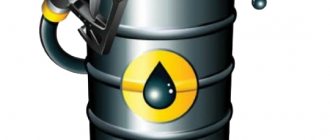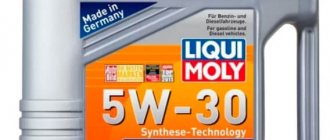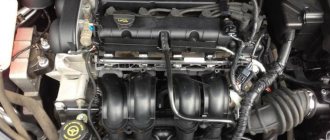How much engine oil is needed for Ford Focus
Generation 1 (1998-2004)
- Engine oil 1.4i 16V – 3.75 l.
- Engine oil 1.6i 16V – 4.25 l.
- Engine oil 1.8 Turbo DI – 5.6 l.
- Engine oil 1.8 Ti – 5.6 l.
- Engine oil 1.8 TDCi 16V – 5.6 l.
- Engine oil 1.8i 16V – 4.25 l.
- Engine oil 2.0i 16V – 4.25 l.
Generation 2 (2004-2011)
- Engine oil 1.4 Duratec 16V – 3.8 l.
- Engine oil 1.6 TDCi HP – 3.8 l.
- Engine oil 1.6 TDCi HP – 3.8 l.
- Engine oil 1.6 Duratec 16V – 4.1 l.
- Engine oil 1.6 Duratec 16V – 4.1 l.
- Engine oil 1.8 TDCi 16V – 5.6 l.
- Engine oil 1.8 Duratec HE 16V – 4.3 l.
- Engine oil 2.0 Duratec HE 16V – 4.3-4.6 l.
- Engine oil 2.0 TDCi – 5.5 l.
Generation 3 (since 2011)
- Engine oil 1.6 - 4.1 l.
- Engine oil 2.0 - 4.3 l.
Changing engine oil Ford Focus 2 1.8
see also
Features of Shell Helix oil
- 161 1 67k
Engine oil quality
- 127 0 61k
Characteristics of motor oils
- 121 0 74k
Gasoline in engine oil
- 24 4 21k
Rosneft oil - what's in the cans?
- 128 6 120k
Calculator for converting liters of engine oil to kg
Converting engine oil from liters to kilograms. Online calculator
The 2nd generation Ford Focus was produced from 2004 to 2011. Focus 2 cars were equipped with petrol engines of 1.4, 1.6, 1.8, 2.0 liters and a 1.6 liter Ti-VCT engine. As well as a 1.8 liter TDDi diesel unit.
The example of a Duratec 1.8 petrol engine shows how to change the oil on a Ford Focus 2.
When to change and how much oil to fill in Ford Focus 2
An oil change for a Ford Focus 2, according to the vehicle repair and operation instructions, should be carried out at 20,000 km or once a year . However, Russian realities make their own adjustments to the frequency of oil changes. If the engine was filled with oil that did not meet quality standards or the car was operated in difficult conditions, for example such as:
- driving on rough and dusty terrain;
- frequent stops and traffic jams;
- towing another vehicle or trailer;
- active throttling and boosting of the engine;
- Frequent trips over short distances.
In such cases, the frequency of oil changes is reduced to 15,000 km , or even to 10,000 km .
To change the lubricant in a Duratec HE 1.8 engine, according to the instructions, you will need 4.3 liters of oil if refilling occurs with a filter. Without taking into account the volume of the entire oil system, in particular the filter, 3.75 liters .
What kind of oil to pour into the Ford Focus 2 engine
For replacement, the manufacturer recommends using original Ford/Matorcraft Formula E SAE 5W-30 engine oil. Provided the WSS-M2C913-B specification is met, other oils, such as Castrol, with the same characteristics can also be used. If it is impossible to purchase a lubricant that meets the WSS-M2C913-B specification, the car owner can use SAE 5W-30 (recommended), or SAE 5W-40 oil, which meets the requirements of ACEA A1/B1 (recommended), ACEA A3/B3 or API (SJ /CF).
Continued use of motor oils that do not meet specifications may affect engine starting, reduce engine efficiency, increase fuel consumption and/or increase engine toxicity.
Necessary tools for changing lubricant
The list of what you will need for the job includes:
- inspection hole;
- 13 mm wrench;
- special key for filter;
- container for draining at least 5 liters;
- mittens;
- new filter;
- new engine oil (5 l canister).
Catalog numbers for consumables
Motor oils . Original synthetic motor oil Ford “Formula F 5W-30” (5 l.) art. - 15595E. Approximate price is about 1700 rubles. Possible replacement with Patron “ORIGINAL 5W-30”. The price of a canister of such oil will be 1,640 rubles.
Filter. Original Ford oil filter art. - 1883037, its price will be 290 rubles. Analogs will cost less, for example: MANN-FILTER W7008 – 240 rubles; Bosch F026407078 – 230 rubles; Amd AMDFL713 – 120 rubles.
Replacement frequency
This section consists of the manufacturer’s recommendations, as well as the subjective opinion of experienced motorists, including owners of the Ford Focus 2. Ford recommends changing the oil after 60-70 thousand kilometers, although this regulation is not suitable for Russia with its unpredictable climate. Taking into account the harsh operating conditions, in this case the replacement schedule will have to be reduced to 10 thousand kilometers. This is the most optimal regulation, under which the oil will not have time to lose its beneficial properties, and this will have a beneficial effect on engine reliability. Thus, it will be possible to prevent premature wear of internal combustion engine parts.
News
Reviews about Autocompas.ru and the work of the staff
A review section has been introduced on the site, using the latest technologies, now each client can write a review from their personal account.
Read completely
Automation of Returns
A completely new and intuitive returns system.
Read completely
Delivery across Russia
Global update of the “Delivery” section! Track numbers in your personal account and convenient cargo tracking.
Read completely
Updated VIN form
An updated form for creating an application for an expert to select spare parts using the vehicle’s VIN code.
Read completely
Generation 2 (2004 - 2011)
Engine Ford Focus 1.4 l. Duratec 16V Sigma (Zetec-SE) 85 HP
- What kind of engine oil is filled from the factory (original): Synthetic 5W30
- Oil types (by viscosity): 5W-20, 5W-30
- How many liters of oil in the engine (total volume): 3.5 liters.
- Oil consumption per 1000 km: up to 200 ml.
- When to change oil: 7500-15000
Engine Ford Focus 1.6l. Duratec 16V (Ti VCT) Sigma 100 and 115 HP
- What kind of engine oil is filled from the factory (original): Synthetic 5W30
- Oil types (by viscosity): 5W-20, 5W-30
- How many liters of oil in the engine (total volume): 3.75 liters.
- Oil consumption per 1000 km: up to 200 ml.
- When to change oil: 7500-15000
Engine Ford-Mazda 1.8l. Duratec-HE/MZR L8 125 hp
- What kind of engine oil is filled from the factory (original): Synthetic 5W30
- Oil types (by viscosity): 5W-20, 5W-30
- How many liters of oil in the engine (total volume): 3.8 liters.
- Oil consumption per 1000 km: up to 500 ml.
- When to change oil: 7500-15000
Engine Ford-Mazda 2.0 l Duratec HE/MZR LF 145 hp
- What kind of engine oil is filled from the factory (original): Synthetic 5W30
- Oil types (by viscosity): 5W-20, 5W-30
- How many liters of oil in the engine (total volume): 3.8 liters.
- Oil consumption per 1000 km: up to 500 ml.
- When to change oil: 7500-15000
Ford Transit engine - how much oil
Fourth generation VE6/VE64, 1986-2003
The 4th generation Transit, compared to its predecessor, was distinguished by a new “box-shaped” body layout with a short hood. From the old model, the car received a four-speed manual transmission and leaf spring suspension on both axles. Also, at the start of sales, the Transit was equipped with a new five-speed manual transmission, and since 1988, instead of springs at the front, a completely independent suspension was installed.
In addition, after restyling in 1988, the wheelbase of the longest modifications increased to 3570 mm (previously it was 3020). The engine range of the 4th generation Transit was the same as its predecessor from 1978-1985. However, in 1989, the top-of-the-line V6 gave way to the EFI V6 Cologne engine. The next update took place in 1992. The restyled model received a new bottom layout, which made it possible to install single-tire wheels at the rear. At the same time, the distance between them increased to 1235 mm. The engines remain the same - these are 2.5 liter diesel engines (69-116 hp) and one 2.0 liter gasoline engine (114 hp).
Also read: Engine oil for Chevrolet Tahoe
Diesel engines 1986-2003
- 2.5 DL, oil volume – 6.15 liters, tolerance and viscosity: API-CF+EC I; SAE 10W-30, 10W-40, 5W-30, 5W-40
- 2.5 DL turbo, oil volume – 6.25 liters, tolerance and viscosity: API-CF+EC I; SAE 10W-30, 10W-40, 5W-30, 5W-40
Fifth generation V184/V185, 2000-2006
The 5th generation Transit had a redesigned design concept, which traced the features of the previous model. At the same time, the new model borrowed design cues from Ford's New Edge, Ka and Focus passenger cars of the time. In addition to the traditional rear-wheel drive for LCVs, the car received front-wheel drive for the first time (for the V185 body), as a result of which handling was significantly improved.
The car went into production with the Duratorq Puma diesel engine family, borrowed from the Mondeo and Jaguar X-Type models of the 2000s. In addition, the car was offered with a 2.3 liter gasoline engine (145 hp), as well as 2.0-2.2 liter diesel engines (75-144 hp). The fifth generation was relevant with different wheelbase options (from 2933 to 3399 mm) and length, and body capacity ranged from 6-14 cubic meters. cm.
Gasoline engines 2000-2006
2.5 turbo RWD T350 6MK, oil volume – 7 liters, tolerance and viscosity: API-SJ+EC I, SH+EC I, SJ+EC I; SAE 10W-30, 10W-40, 5W-30, 5W-40
Diesel engines 2000-2006
2.0 TDdi, oil volume - 6.7 liters, tolerance and viscosity: API-CF+EC I, CG+EC I, CG-4+EC I, CH+EC I, CH-4+EC I; SAE 10W-30, 10W-40, 5W-30, 5W-40
Sixth generation V347/V348, 2006-2014
The 6th generation Transit, in comparison with its predecessor, had a similar body layout with angular shapes characteristic of other LCV class models. At the same time, the car was radically different from the 5th generation due to vertically mounted headlights and a massive radiator grille. In addition, the car received a higher quality interior with improved finishing and additional options. A new gasoline engine from the Ford Ranger has appeared in the engine range, and diesel engines have received a new HPCR (TDCi) system. All engines have switched to a new environmental standard to adapt to European standards.
At the same time, the toxicity of Transit engines continued to decrease. So, in 2008, the car was adapted to the new Euro-4 environmental standards. With front-wheel drive, the car was produced with a 2.2 liter diesel engine (85, 115 and 140 hp), and rear-wheel drive Transits were equipped with a 2.4 liter diesel engine with a power of 100, 115 or 140 hp. With. A 200 hp Duratorq TDCi was also available. The all-wheel drive Transit was available exclusively with the Duratorq TDCi 2.4 (140 hp). The rear-wheel drive car was also offered with a 2.3-liter Duratec gasoline engine running on gas fuel (LPG/CNG).
Diesel engines 2006-2014
- 2.2 85 l. With. (P8FA, P8FB), front-wheel drive, oil volume - 6.7 liters, tolerance and viscosity: API-CH-4+EC I, CI+EC I, CI-4+EC I, CI-4+EC II; SAE 10W-30, 10W-40, 5W-30, 5W-40
- 2.2 100 l. With. (DRFA), front-wheel drive, oil volume - 6.2 liters, tolerance and viscosity: API-CH-4+EC I, CI+EC I, CI-4+EC I, CI-4+EC II; SAE 10W-30, 10W-40, 5W-30, 5W-40
- 2.2 115 l. With. (SRFA), front-wheel drive, oil volume - 6.14 liters, tolerance and viscosity: API-CH-4+EC I, CI+EC I, CI-4+EC I, CI-4+EC II; SAE 10W-30, 10W-40, 5W-30, 5W-40
- 2.2 125 l. With. (CYFA), rear wheel drive, oil volume - 7 liters, tolerance and viscosity: API-CH-4+EC I, CI+EC I, CI-4+EC I, CI-4+EC II; SAE 10W-30, 10W-40, 5W-30, 5W-40
- 2.2 140 l. With. (PGFB), front-wheel drive, oil volume - 6.14 liters, tolerance and viscosity: API-CH-4+EC I, CI+EC I, CI-4+EC I, CI-4+EC II; SAE 10W-30, 10W-40, 5W-30, 5W-40
- 2.2 155 l. With. (CVRA), rear wheel drive, oil volume - 10.55 liters, tolerance and viscosity: API-CH-4+EC I, CI+EC I, CI-4+EC I, CI-4+EC II; SAE 10W-30, 10W-40, 5W-30, 5W-40
- 3.2 200 l. With. (SAFA, FAFB), rear wheel drive, oil volume - 10.1 liters, tolerance and viscosity: API-CH-4+EC I, CI+EC I, CI-4+EC I, CI-4+EC II; SAE 10W-30, 10W-40, 5W-30, 5W-40
Also read: Motor oil for the UAZ-469 engine
Seventh generation since 2014
The 7th generation Transit stands out from its predecessor with a new design of the front end, which looks impressive due to the large headlights and massive radiator grille. The seventh generation is notable for the fact that its family includes modifications with a load capacity of 2000 kg. The car has rear-wheel drive, front-wheel drive or all-wheel drive, and is also equipped with gasoline and diesel engines. A restyled Transit will be produced in 2021. Depending on the modification, its body length can reach from 5.53 to 6.7 meters (six options in total), and its body height can be 212, 256 or 280 cm.
Diesel engines since 2014
- 2.2 DuraTorq-TDCi, front-wheel drive, oil volume - 6.2 liters, tolerance and viscosity: API-CI-4+EC II, CJ+EC II, CJ-4+EC II; SAE 10W-30, 10W-40, 5W-30, 5W-40
- 2.2 DuraTorq-TDCi, rear wheel drive, oil volume - 9.7 liters, tolerance and viscosity: API-CI-4+EC II, CJ+EC II, CJ-4+EC II; SAE 10W-30, 10W-40, 5W-30, 5W-40
- 2.4L Duratorq-TDCi, oil volume - 8.8 liters, tolerance and viscosity: API-CI-4+EC II, CJ+EC II, CJ-4+EC II; SAE 10W-30, 10W-40, 5W-30, 5W-40
- 3.2L DuraTorq-TDCi, oil volume - 11.4 liters, tolerance and viscosity: API-CI-4+EC II, CJ+EC II, CJ-4+EC II; SAE 10W-30, 10W-40, 5W-30, 5W-40
What and how much to fill in Ford Focus III
| Refueling/lubrication point | Filling volume, liters | Name of material/liquid | |
| 1.6 l (105 and 125 hp) | 2.0 L (150 hp) | ||
| Fuel tank | 55 | 55 | Unleaded gasoline with an octane rating of at least 95 |
| Engine lubrication system: with filter without a filter | 4,1 3,75 | 4,3 3,9 | SAE 5W-20 and SAE 5W-30 oil meeting Ford WSS-M2C-913-B, WSS-M2C-913-C, WSS-M2C-925-C or SAE 5W-30 oil meeting ACEA A5/B5 requirements |
| Cooling system | 5,8 | 6,3 | Motorcraft SuperPlus or antifreeze meeting Ford WSS-M97B44-D |
| Windshield washer: with headlight washer without headlight washer | 4,5 3 | 4,5 3 | In summer - a concentrate of special liquid for the washer reservoir, diluted with clean water, in winter - anti-freezing liquid |
| Transmission | 2,4 | 2,4 | SAE 85W90, API, GL-4 |
| Hydraulic brake system/hydraulic clutch release | Up to the “MAX” mark 1.2-1.5 liters | Up to the “MAX” mark 1.2-1.5 liters | Ford brake fluid, Motorcraft Super DOT4 or Ford brake fluid WSS-M6C57-A2 |
| Hydraulic power steering | Without rinsing - 1 liter with rinsing 1.5 liters. | Without rinsing - 1 liter with rinsing 1.5 liters. | Red - Ford WSA/M2C938/A. article 1776431 Green - M2С204/А2 USA. article number 1781003 |
| Constant velocity joints of front wheel drives | — | — | CV joint-4, CV joint-4M, imported lithium-based lubricants with 5% molybdenum |
PS: Dear car owners, if you have your own information on this topic, please tell us about it in the comments or write an email to the site administration.
Find out from us also: Location of elements under the hood of Ford Focus 3
(
8
votes: average:
4,63
out of 5)
Loading…
Fourth generation C519, since 2018
The 4th generation Focus features a stylish coupe-like design. The car is based on a completely new C2 platform and technically has nothing in common with its predecessor. For the first time, the model received full LED headlights and an eight-speed automatic transmission in the form of a rotating puck.
It is also possible to order a panoramic cover and the so-called Head Up Display (a projection indicator on the windshield). The wheelbase has increased by 53 mm, providing additional space at the front and rear. The quality of the finish has improved and the center console has been completely changed. It is now possible to order the Active version with increased ground clearance (+30 mm), as well as the luxury Vignale version. In Europe, the 4th generation Focus is available with three- and four-cylinder engines – gasoline and diesel. Gearboxes – manual and automatic.
Gasoline engines from 2018
- 1.0 100-125 l. pp., oil volume – 4.1 liters, tolerance and viscosity: API-SN; SAE 5W-40, 5W-30, 10W-30, 10W-40
- 1.0 150 l. pp., (M8DA), oil volume - 4.1 liters, tolerance and viscosity: API-SN; SAE 5W-40, 5W-30, 10W-30, 10W-40
Diesel engines from 2018
1.5 95-120 l. With. (Ecoblue), oil volume - 3.8-4.0.5 liters, tolerance and viscosity: API-SJ-4; SAE 5W-40, 5W-30, 10W-30, 10W-40
Also read: Motor oil for the VAZ 2115 engine
Motor oil Ford Focus 2 petrol
There are much more diesel engines in the Ford Focus 2 line of engines running on gasoline fuel. Moreover, all these internal combustion engines operate on motor oil with WSS-M2C913-B approval. Oils with alternative approvals WSS-M2C913-C and WSS-M2C913-D can also be used. This is primarily the original Ford Formula F 5W30 oil, which meets all these tolerances. Well, or its substitutes with a similar viscosity GULF Formula FS 5W-30, LIQUI MOLY Molygen New Generation 5W-30 and so on.
| Ford Formula F 5W30 | 4 liters Article: 14E8BA Average price: 2300 rubles 1 liter Article: 14E8B9 Average price: 650 rubles |
| GULF Formula FS 5W-30 | 4 liters Article: 5056004112725 Average price:2100 rubles 1 liter Article: 5056004112718 Average price: 600 rubles |
| LIQUI MOLY Molygen New Generation 5W-30 | 5 liters Article: 9043 Average price: 4000 rubles 1 liter Article: 9041 Average price: 1050 rubles |
How to change oil in Ford Focus 2
- Ford Focus - history of the 2nd generation
- Motor fluids for Focus
- How to change oil fluid
Among all the brands of cars sold worldwide, the majority are little-remembered “average” cars. There are also unsuccessful models. But all this does not apply to the legendary Ford Focus. This small C-class family car has become a bestseller throughout the European continent, including Russia. Over the entire period of production, from 1999 to the present day, more than half a million of these cars have been sold in the Russian Federation. From 2002 to the present, the car has been produced at a plant in Vsevolozhsk, near St. Petersburg.
Ford Focus - history of the 2nd generation
If we talk only about the 2nd generation car, then this car was produced from 2004 to 2011. The basis of the model is the C1 platform. The same foundation, called Global Shared Technologies, is laid in such well-known cars as the Volvo S40, V50, C70, Mazda 3. New transmissions for that time began to be installed on the Ford Focus - a 6-speed manual and a 4-speed automatic transmission.
What sets this model apart from other versions of the Focus is the well-thought-out safety of passengers and the driver. EuroNCAP, having conducted crash tests, awarded this vehicle the highest rating - 5 stars. The Russian market offered buyers cars with engines of 1.4 liters (80 hp), 1.6 (100 and 115 hp), 1.8 (125 hp), 2.0 (145 hp) ), as well as a 1.8 liter turbocharged diesel engine (115 hp)
2008 was marked by a restyling of the model. To produce new cars, the plant in Vsevolozhsk was re-equipped with new equipment. The car began to be produced with several body versions - 3 and 5-door hatchback, station wagon and sedan. By the way, sedans are the most popular among Russians. Over the entire period, half of all cars produced in Russia were produced with such bodies. Motorists were offered 3 trim levels of the 2nd generation Focus - Ambiente, Comfort and Ghia.
In 2008, Ford Focus 2 received the honorary title of “Car of the Year” on two continents at once - European and North American. Today, the third generation of this legendary model is being produced near St. Petersburg.
Motor fluids for Focus
Just like any car, the Ford Focus 2 uses lubricants for its engine. The manufacturer stipulates that engine oil for Ford Focus 2 must meet the approvals of Ford WSS-M2C913-A, Ford WSS-M2C913-B and C. This means that oil fluids must meet categories GF2, GF3 of the ILSAC classifier, and also have levels A1 /B1 ACEA specifications. The viscosity of the product is 5W30, it should be used as a mixture for first and service fills during the warranty period.
On the assembly line, Ford Formula F oil with a viscosity of 5W30 is poured into Ford cars for the first time. This product contains additives that are optimally suited for Ford engines and adapt new engines to long-term operation. Complies with all the above tolerances. The basis of the composition is synthetic.
The lubricating mixture starts the power unit well at low temperatures. Can be used for almost all Russian regions. Pour point – minus 42°C.
Advantages of the lubricant, appreciated by users:
- Good ductility in the cold allows you to quickly start the engine, lubricant immediately flows to its parts.
- It is the viscosity that ensures the optimal viscosity of the lubricant, allowing you to save fuel and waste little lubricant. Evaporation is also minimal.
- Changing the oil in a Ford Focus 2 allows you to use fresh working fluid for 10–12 thousand kilometers, although the manufacturer recommends replacement after 20 thousand. The difficult operating conditions typical of Russian roads should be taken into account.
- Protects bearings and valve mechanisms especially well, even under very difficult operating conditions.
- Provides protection of the crankshaft, as well as the cylinder-piston group, from scuffing and damage.
- Detergent additives to the base composition remove carbon deposits, varnish deposits and sludge. And dispersed ones keep them suspended until they settle on the surface of the filter element.
- Prevents corrosion of metal surfaces of parts.
- Friction modifiers can increase engine efficiency, and anti-wear additives can increase its service life without repairs.
Good stability of the lubricant is indicated by a viscosity index of 170. The API standard assigned the product the SM/CF category. You can also use fluids from other manufacturers that have the above approvals from Ford.
This is not a complete list of lubricants that can be used for motors developed for the 2nd generation Focus. Everything will depend on the price and preferences of each motorist. Separately, I would like to note that there are many counterfeit products of fluids such as Ford Formula F 5W30 on the Russian market. Therefore, they should not be bought from dubious sellers in the markets. It is best and safest to purchase from authorized dealers. There the risk of getting a fake is minimized.
How to change oil fluid
In relation to a Ford Focus 2 car, changing the engine oil can be done independently if the warranty period has already expired. For this you need an inspection hole or overpass. In addition, you need to purchase a fresh oil mixture from the above in a volume of 5 liters. Such canisters are available for sale. A new oil filter is also needed. From available materials you should prepare:
- » alt=»» /> container for waste material with a volume of 5–6 liters;
- » alt=»» /> rags and wire brush;
- » alt=»» /> keys for 13 and 17, as well as a device for removing the filter.
If you switch to another lubricant, it is advisable to clean the engine before replacing. Flushing liquids are produced for this purpose; the conditions for their use are written on the labels. Before changing the oil, you need to drive it, warming up the engine well.
- The machine is placed above an inspection hole or on an overpass.
- The engine protection is removed using keys.
- The filler neck under the hood is unscrewed.
- Use a 13 key to loosen the drain plug, and install a waste container under the crankcase.
- The drain plug is unscrewed and the lubricant flows into the container. You have to be very careful not to burn your hands.
- After some time, as soon as the liquid has stopped leaking, the crankcase near the drain plug is wiped and screwed into place.
- The filter is changed - the old one is unscrewed. The new one is filled 1/2 with fresh oil, and the seal on the filter is lubricated with it. The new filter is screwed in by hand, without much effort.
- New lubricant is poured through the filler neck, the volume is 4.5 liters.
- The neck closes, the engine starts, the oil pressure sensor should go out.
- After the engine has been idling for five minutes, it turns off.
- The dipstick measures the oil level. It should be in the middle, between the min and max marks.
Finally, you should check whether oil is leaking through the filter and drain plug. After this, you can continue traveling in your car.
Type of oil
- Synthetics are one of the most modern motor oils today. This lubricant has the best beneficial properties, which are considered to be the best in terms of durability. Accordingly, this has a beneficial effect on the replacement schedule. Semi-synthetic oil does not freeze and is resistant to low temperatures. It can be recommended for Ford Focus 2 with low mileage
- Mineral oil is the most affordable option on the lubricants market. Recommended only for high mileage, but with some reservations. For example, due to its thickness, such oil is prone to freezing at low temperatures
- Semi-synthetic oil - includes 70% mineral oil and 30% synthetic product. The liquid is poorly resistant to extremely low temperatures. This product can be recommended if there is a shortage of funds for synthetic oil, or as an alternative to cheap mineral water.
Analogue oils
Given the wide range of lubricants, today it is not necessary to buy the expensive original Ford Formula F 5W-30. You may prefer an equally high-quality analogue oil - for example, the American Motorcraft Full Synthetic 5W-30 S API SN. This is a synthetic oil with Ford proprietary tolerances. In addition, Motorcraft oil is almost half the price of the original.
Other equally high-quality analogues suitable for the Ford Focus 2 include Castrol Edge 5W-40 Fully Synthetic, Castrol Magnatec 5W-30 and Motul 5W-30 913C.

